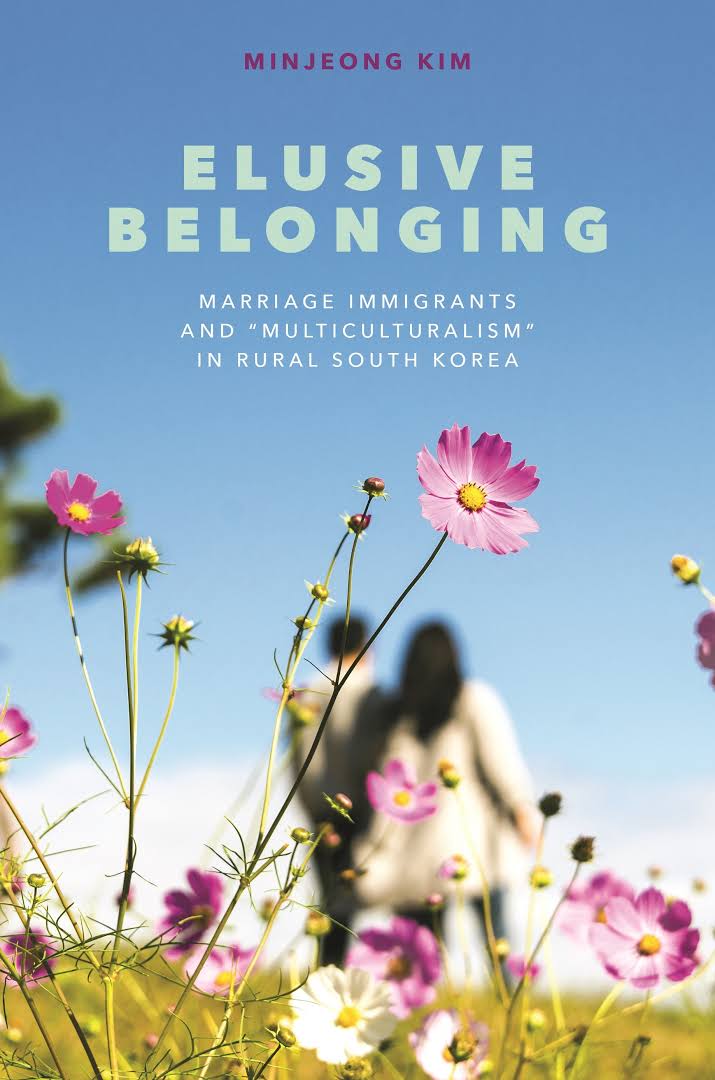Revisiting the fairy and the woodcutter story
Minjeong Kim. 2018.
Elusive Belonging: Marriage Immigrants and ‘Multiculturalism’ in Rural South Korea
Honolulu: University of Hawai‘i Press
ISBN 9780824869816
Contemporary South Korea is seldom thought of as made up of towns and immigrants. In Elusive Belonging, Minjeong Kim studies both, providing an ethnographic account of the lives of Filipina women who married South Korean rural bachelors in two close localities where the author conducted fieldwork in the mid-2000s. By the time Kim immersed herself in the activities and experiences of this community, more than one in every 10 new marriages concluded in South Korea was defined as international, i.e. as involving a foreign-born individual. This proportion represented a marked increase compared with the rate of one in every 100 unions at the beginning of the 1990s. From one decade to the next, change in international marriage trends has not only been in numbers, but also in diversity. While international marriages were overwhelmingly contracted between Korean women and foreign-born men – notably American soldiers – until the early 1990s, they have since primarily involved Korean men and foreign-born women from countries such as China, the Philippines, and Vietnam.
Although recent, these demographic transformations have already attracted significant scholarly attention as Kim does not fail to mention. Research to date has not only centered on marriage immigrants and their families but also on the response of the South Korean state through its multiculturalism project. The gendered and ethnocentric foundations of this project have been analyzed by a large body of literature particularly critical of how South Korea’s multiculturalism expects and incites marriage immigrants to work and assimilate in the domestic space through their role as caregivers. In Kim’s words, “Marriage immigrants’ maternal citizenship presupposes immigrant mothers as ‘Other subjects’ to be Koreanized and domesticates them as mother citizens” (p.48). The contribution that Elusive Belonging adds to the existing critical scholarship rests on telling the intimate stories of Filipina women engaged in the process of building this and other forms of citizenship in the South Korean countryside, where no less than one third of the marriages involve foreign-born brides. The focus of the book is therefore on marriage immigrants’ own agency and the varied emotions – such as love, gratitude, and anxiety – underpinning the choices they can make as well as those that are imposed upon them in the private and public realms.

By adopting such a lens Kim is enabled to reject “the image of international marriage immigrants as passive brides or victims of sex trafficking” while venturing “beyond the problems faced by marriage immigrants that have inundated popular and academic discourses”, such as social discrimination and domestic violence (p.22). Her aim is obviously not to negate the reality of these experiences but to enrich our understanding of how women who immigrated for marriage to rural South Korea navigate their lives in the early 21st century. Following the ‘emotional turn’ that has affected migration and citizenship studies, Kim explores the attachments and frustrations shaping these women’s sense of belonging in the country of their spouses, who are neither depicted as villains nor princes charming. Husbands themselves are not only taken into account in the book but they are also given a voice, alongside the state and civil society’s multicultural agents as well as the Unification Church, the main matchmaker for the couples Kim encountered. In accordance with her objective to revisit the dominant perception of marriage immigrants as passive victims, Kim also challenges the assumption that their spouses are fundamentally abusive and exploitative.
In this respect, the book’s central chapters (three and four, out of seven) can be seen as written against two kinds of fairy tales in which women are alternatively portrayed as saved or oppressed by marriage. Chapter 3 discusses the possibility of love among foreign brides and rural bachelors without romanticizing it, offering the idea that ‘heterosexual scripts’ can account for the intimacy that may develop between strangers despite communication barriers posed by language and culture. Even when love is present in their lives, the fate of Filipina women is never idealized as they join husbands who are importantly situated as “subordinate subjects of Korea’s neoliberal economic system” (p.90). This position is analyzed by Kim as bringing about a range of anxieties in rural families. Chapter 4 argues that the material insecurity these families face can translate into adverse effects on foreign-born wives, particularly under the form of restrictions on their physical mobility and economic agency. Yet, the author refuses to reduce domestic tensions and conflicts to ‘the Fairy and the Woodcutter Syndrome’, an expression coined by the South Korean media after a folktale believed to capture the unequal power dynamics of international marriages.
In the tale, a solitary woodcutter entraps a fairy into marrying him by stealing her clothes while she is bathing. This leaves the deceived creature no choice but to escape after having given birth to two children that she takes away with her. The many trajectories that Kim retraces include some of departure – a term she prefers to escape – toward the book’s end. Even then, her emphasis remains on the diversity and complexity of Filipina women’s lived experiences, making Elusive Belonging a necessary read for anyone interested in the marriage immigrants’ side of the story – a story of ‘immigration for marriage’ rather than ‘marriage for immigration’ that Kim convincingly chooses to tell in the plural rather than in the singular.
Justine Guichard, Université de Paris, France